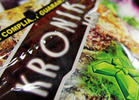
We live in a golden age of American cannabis connoisseurship. Pineapple Express and Blue Dream can be found from coast to coast. But some people have been passing on all the excellent pot in favor of a new designer drug - K2, Spice and other products containing synthetic cannabinoids - being sold and smoked in the United States. Marketed as incense, they can be purchased in head shops and convenience stores in silver pouches that contain random plant matter sprayed with chemicals.
K2 and Spice products have been dubbed, incorrectly, as “synthetic marijuana” by the media because the main high-producing ingredients, JWH-018 and others, are chemical compounds that activate the cannabinoid receptor system. But these chemicals were created for laboratory research and work in a much different way than natural pot.
Some of the attraction to K2 and Spice-like products is getting a legal, un-prohibited high with the ability to pass a standard drug screen. However, companies are now marketing urine tests that claim to detect the chemicals in these products.
Jahan Marcu is one of the few cannabinoid scientists in America. Based at Temple University in Philadelphia, he also serves on the medical advisory board of Americans for Safe Access. The following interview was conducted in 2010.
As someone who is familiar with JWH-018 and these other synthetic cannabinoids in the lab, what is it like to see these things on the streets?
Think about the guys who invented JWH-018. This is probably the worst nightmare imaginable for a researcher to have the product of their hard work for many years, decades maybe, turned into a designer drug of abuse. Because then it gets banned and essentially your chapter in research history is over because your access to the drug vanishes. If they go systematically down the list banning all of the JWH compounds, those are less compounds we can use to enhance our knowledge of how the endo-cannabinoid system works.
What do you think of the bans of K2 and Spice products?
As someone who’s in research and education my idea would be: Well, let’s see how dangerous these compounds are. Let’s go ahead and fund a bunch of small studies in animals. Let’s have some people who are already taking these drugs volunteer for some tests. Then we can look at them with side-by-side comparisons with alcohol and marijuana for impairment, and really get a good risk assessment. But that’s not going to happen,. There’s just going to be bans and an absence of knowledge.
Are these synthetic cannabinoid compounds something that humans should be smoking?
No. The main reason is the animal data that is coming back is not that promising. It’s very potent at low doses. At around 10 mg per kilogram in rats there's decreased breathing rates and respiratory depression from these compounds that strongly suggests that those effects are not mediated through the cannabinoid receptor system.
So then they're dangerous to use?
No one has hooked up a Spice cigarette to a gas chromatograph and analyzed the smoke. Those studies have been done with tobacco and marijuana for decades. We have a wealth of information about whole plant marijuana. So you know way more what you're getting into when you use a drug like cannabis.
What's up with drug testing for K2 anf Spice?
The structure of JWH-018 and (natural) THC is very different. If you looked at the two compounds side-by-side you would not have to be a chemist to see that they look vastly different. The unique part of JWH is the indol ring: It’s a two-ring structure with one nitrogen; this is a common motif found in other hallucinogens like LSD, mescaline and psilocybin, but is not found in (natural) THC. Researchers have found that the body modifies the indol ring in JWH-018 and thus have developed the drug test around that modification. You’d have to be smoking a fair amount of Spice to be found in a urinalysis.
How is the lab community dealing with this K2/Spice phenomenon?
These compounds are very important to research. It would be a great loss to the scientific community if they were no longer available for research. It’s a shame that unscrupulous business practices are ruining this for the scientists. In the end, because there is no real labeling of these products, the most dangerous things in Spice may not be the chemicals we actually know about, but what we don't. Prohibition of natural marijuana seems to be the only driving force behind the emergence of these new synthetic drugs. Politics and not science are behind the Spice bans. To advocates, this is an additional and rather poignant public safety reason for natural marijuana to be fully legalized, right now.






